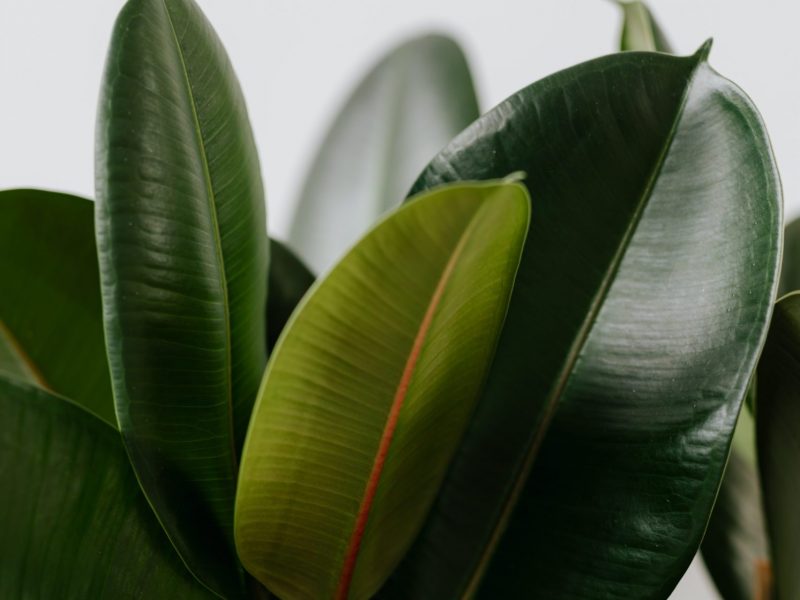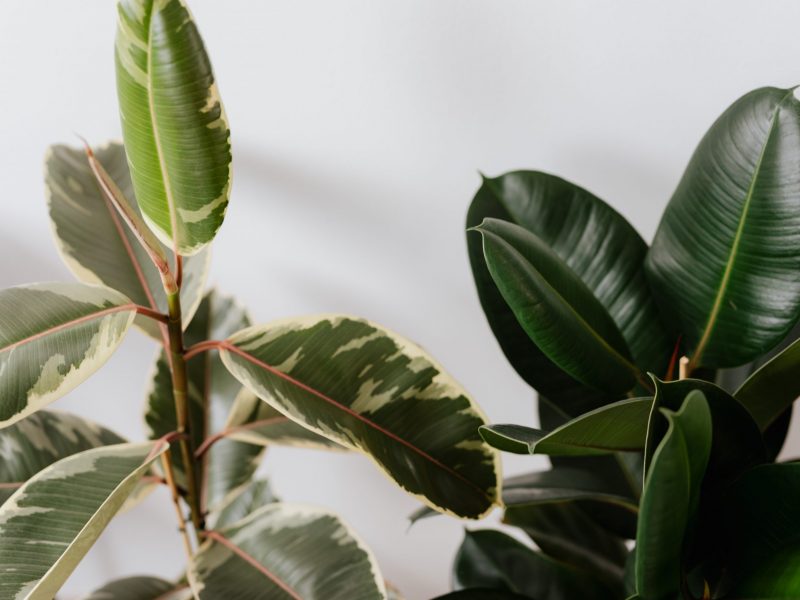
Rubber Plants are fairly hardy plants that can be really easy to care for. However, if you do start to notice that your Rubber Plant’s leaves are curling or wrinkling, this may be a symptom of incorrect care or environment. There are quite a few different causes that can all mean your plant starts to curl some of its leaves so it’s important to make the right diagnosis before changing anything.
The main reasons why your rubber plant’s leaves are curling and/or wrinkled are: over- or underwatering, dry air, cold temperatures, pest infestation, a sudden change of environment or simply natural wrinkling. In this article, we will cover all of the reasons in more detail along with how to treat the problem and stop it from harming your Rubber Plant again in future.
Overwatering may be causing curling leaves
Improper watering is one of the biggest issues for most houseplants and Rubber Plants are no different. Whilst they are definitely a lot less sensitive than other plants, overwatering them can cause some real issues over time. One of the most common issues caused by overwatering your Rubber Plant is curling or wrinkled leaves, so we recommend this as the first issue to check out when trying to diagnose the problem.
Curling leaves are also one of the earlier warning signs when it comes to overwatering. So if your plant isn’t showing any other signs of distress then it hopefully means you have caught the issue early. With the right methods you should be able to get your Rubber Plant back to full health and avoid any more permanent issues such as brown/yellow leaves, leaves falling off your plant and even plant death altogether.
Rubber Plants hate it when their soil is too damp and overwatering will cause their leaves to start curling upwards. During the warm growth months, you should not be watering your Rubber Plant more than once a week. During the colder months, once a month is definitely enough.
It is really good to get to know your plants as each and every one is ever so slightly different. As well as checking the moisture at the top of the soil before watering, we also recommend picking up your Rubber Plant before and after watering so you get an idea of much your plant will weigh when it needs water. Using a moisture meter is also a great way to take the guessing out of watering your Rubber Plant. You just pop them in the soil and it’ll tell you how dry or damp the soil is. If your Rubber Plant’s soil is waterlogged, we recommend replacing it and adjusting your watering pattern. This should hopefully stop your Rubber Plant’s leaves from wrinkling drastically.
If you’re particularly worried that you might overwater your Rubber Plant it could be worth investing in a good quality self-watering plant pot, these take all of the trouble out of the process and will make sure that your plant isn’t resting in stagnant water – eliminating the risk of root rot or other watering based issues. They are also super useful if you find yourself forgetting to water your plants, or needing to be away from home for long periods of time. They give you a lot of peace of mind and mean you don’t have to rely on others to pop over and water your beloved plants.
Underwatering can also cause leaf curl in Rubber Plants
Too little water can also cause your Rubber Plant’s leaves to start curling. Although they hate their soil being too soggy as we leant above, they also cannot deal with dry soil for too long. It dries out the root system, making it crisp up and means your plant is unable to take up vital nutrients and moisture from the soil. As with overwatering, curling leaves tends to be an early sign that your plant needs more water as this is often their initial defence against water loss through the leaves.
Before you go changing anything about how much you water your plant, you need to confirm the issue is caused by a lack of water. It would be pretty harmful to give your plant more water if it didn’t need it.
Confirm the issue by checking the moisture levels in the soil. You can do this easily using a moisture meter. However, if you don’t have one then the finger/chopstick method works great. If your plant is quite young then you can also try lifting it up to gauge how soggy the soil is but as Rubber Plants can grow quite tall, we don’t recommend this for bigger plants as you don’t want to hurt yourself in the process.
If you find that your Rubber Plant’s soil is bone dry, then underwatering is probably what is causing the curling/wrinkled leaves. Make sure to either increase how frequently you are watering your plant, or how much water you are giving it each time. Either option will help prevent the roots from crisping up and the leaves from curling or wrinkling again in future.
Be slow when reintroducing water though so we recommend a little once a day for a few days. This will slowly moisten the soil and avoids any shock.
If the air is too dry, your Rubber Plant’s leaves will curl
Rubber Plants like quite humid environments and can struggle in homes with dry air. This can be especially damaging in winter months when we often have the heating on for several hours a day. A lack of humidity in the air can cause your Rubber Plant’s leaves to curl, and eventually maybe even fall off. If you feel you have quite dry air, make sure to mist your Rubber Plant every few days with a spray bottle, this should help prevent the plant from drying out.
If you want an even easier solution to humidity issues, consider investing a humidifier. These affordable little devices make it super easy to keep a more consistent increased humidity level.
Check out our houseplant humidity guide for more information on humidity levels and how you can really easily raise or lower the humidity depending on your plant’s needs.
Cold temperatures are also a cause of wrinkling leaves
Another cause of curling or wrinkled leaves that you need to monitor is temperature extremes, particularly cold temperatures. If your Rubber Plant is being exposed to drafts it can cause shock and distress and mean the leaves curl up in response.
Make sure that your plant isn’t too close to any drafty external windows or doors as you might not realise it but even the smallest crack can lead to some pretty chilly drafts in winter. If your plant is curling its leaves in summer, then check that it isn’t standing too close to any air conditioning vents. Although the cool breeze might be a nice break from the heat for you, it can be pretty damaging to your Rubber Plant.
We strongly recommend using a digital thermometer if you don’t already to keep track of any changes in temperature around your plant. It can help you figure out if you need to relocate your plant and ensure it is growing in the right temperature range.
A pest infection may also be causing your Rubber Plant’s curling leaves
Whilst it is pretty rare for your Rubber Plant to be suffering from a pest infestation, it is vital that you check the leaves every so often, even if your plant looks super healthy as pests can be a cause of curling or wrinkling leaves in Rubber Plants! If your plant spends any time outdoors then this is definitely a potential cause and you should always give your plant a good once over before bringing indoors to minimise the risk to your other houseplants.
Use a magnifying glass to inspect your plant and if you find bugs isolate your plant from all others in the room to stop the pests from spreading across your urban jungle.
To treat the pests, wipe each leaf with warm soapy water to try and remove as many as possible. We also recommend giving your plants a shower but make sure the water pressure isn’t on full or this could damage your Rubber Plant’s leaves. Depending on the scale of the infestation, you might also want to treat your plant with neem oil and an insecticide.
Curling leaves can also indicate too much light
If your Rubber Plant is wrinkling its leaves during the height of summer, then it might be receiving too much intense light. They tend to thrive best with indirect sunlight and can curl up their leaves to protect themselves against direct sun rays.
If your Rubber Plant is in a spot that receives several hours of intense direct light then you probably want to move your plant to a slightly shadier spot. Luckily, if there aren’t any other issues such as brown or yellow patches on the leaves, then you have caught the problem early before it has caused any irreversible damage to your Rubber Plant!
In future, to prevent the leaves from curling due to light stress, ensure that your plant isn’t getting any direct sunlight during summer. It’s OK for it to receive more light in winter as the sun is weaker and the days are shorter. So it might simply be a case of moving your plants around a bit depending on the season.
Sudden changes in environment can often cause curling leaves
Much like humans, houseplants can get pretty stressed out if any changes occur. Things like repotting, propagating or moving to a new spot can cause your Rubber Plant to get a little shocked and the leaves may start curling. It is nothing to worry about and it will just take some time for it to return to normal and for the leaves to naturally uncurl.
One thing to make sure of if you have moved your Rubber Plant to a new spot is that the conditions are the same, if not better than the one it was previously in. Your Rubber Plant will probably survive if the conditions are less suited to its requirements but it may just grow a little slower than before. The best way to determine if the environment is right is by using a light meter, as well as a thermometer and humidity gauge.
New Rubber Plant leaves tend to curl at first
If it is only the new leaves on your Rubber Plant that are curling or wrinkling then this is natural. As new leaves grow they will shoot up from the main stalk very tightly curled. As the leaf matures it will slowly uncurl. As long as the leaf gradually uncurls, and all of the other leaves look healthy then you have absolutely nothing to worry about and it is just your plant maturing!
Curling Rubber Plant leaves isn’t a problem that you need to get overly stressed about. Rubber plants won’t die on you suddenly if something isn’t right so just make sure to keep an eye on its environment and your care for a few weeks to spot any glaring problems. Check out our Rubber Plant care guide for more information on other common problems as well as general care tips to help your plant thrive!














